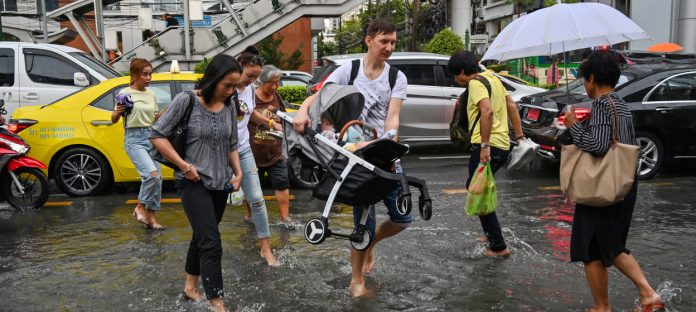Climate change will drastically affect ASEAN’s tourism industry if regional measures on climate adaptation are not taken to ameliorate its potential negative effects on key tourist sites.
The disruptions in global mobility caused by the Covid-19 pandemic are still deeply affecting ASEAN’s tourism industry, as the region lost 8.4 per cent in total GDP from the drastic drop in tourist arrivals. With worsening climate disasters expected, the region is at risk of falling further behind in its development goals. As the region’s economies gradually reopen to tourism, embedding climate projections and bold environmental policies in tourism policy is increasingly necessary.
Several ASEAN countries have actively boosted vaccination rates and dropped travel restrictions, establishing conditions that will allow them to quickly reopen to revive tourism. While the pandemic is a medium-term challenge that would partially be resolved once most countries reopen, climate change is a long-term issue that poses different problems for the industry.
Tourism is one of the most vulnerable industries to climate change. Many of ASEAN’s beaches and coral reefs have been seriously damaged by climate change, such as the inland erosion of up to 150 metres along 3 kilometres of Vietnam’s Cua Dai Beach and the significant increase in coral bleaching in Indonesia, the Philippines and Thailand. Climate change also affects cultural heritage. At least three UNESCO world heritage sites in Southeast Asia have been assessed as being the most vulnerable to future storms and floods: the risk of landslides in ancient Hoi An in Vietnam, the vegetation change of Komodo National Park in Indonesia, and soil erosion at the Cordilleras rice terraces in the Philippines.
Extreme weather events with more frequent and devastating storms, floods and droughts will also create tourism displacement flows. Tourists will likely shun areas with unpredictable and dangerous weather conditions and go to safer locations. The cost of responding to climate change, whether borne by local governments or tourist businesses, will likely be passed on in price increases for tours, attractions and tourist visas, which might ironically make tourists choose less expensive destinations with weaker climate policies. For Indonesia, one of the most vulnerable countries to climate change, the latest studies show that every 1 per cent increase in temperature and relative humidity is associated with a decrease in the number of international tourists by 1.37 per cent and 0.59 per cent, respectively. A vicious cycle might develop, if government budgets for the repair and maintenance of tourism sites affected by climate change and climate adaptation measures are constrained as income decreases due to declining visitor arrivals.
Failing to do so might mean that the very tourist attractions that woo visitors to ASEAN might be lost forever to rising seas and powerful storms.
Since climate change is a problem that affects all ASEAN countries, it requires collective action based on common principles rather than piecemeal initiatives by individual member states. While the pandemic reduced the greenhouse gas emissions globally by 7 per cent in 2020 with mass lockdowns in many countries, this reduction barely meets the goals of the Paris Agreement and emissions have resumed to pre-pandemic levels. Specific and concrete regional tourism strategies and regulations related to climate change are needed. There is the ASEAN Tourism Strategy Plan 2016-2025, which stresses environmental preservation and climate change adaptation measures in tourist growth. However, ASEAN still lacks common guidelines on environmental protection and climate change adaptation for the tourism industry, and individual countries are falling woefully short of action on renewable energy, reducing emissions, and sustainable tourism.
Currently, there are some projects in the world that offer specific frameworks and practices for climate change adaptation tourism, such as the Eco-union’s Strategic Guide to Climate Change Adaptation of Tourist Destinations for the Mediterranean. Adaptation measures, such as accepting the impact and managing the effects of climate change, preventing or reducing exposure, and adopting early warning systems, must be clearly chosen and evaluated with the participation of local stakeholders. The strategic planning process should then define and allocate roles and duties to stakeholders. Furthermore, metropolitan regions such as Bangkok (Thailand) and Ho Chi Minh City (Vietnam), among ASEAN’s most popular tourist zones, should not be overlooked in the development of climate-adaptive tourism.
The World Trade Organisation’s Guide to Climate Change Adaptation in Cities suggests that cities can amend their master plans for land use and transportation while also investing in infrastructure to increase climate change resilience, such as improving the road network in a densely populated floodplain. In particular, the report highlights the need for accurate data collection, one of the challenges facing developing countries in monitoring, verifying, and assessing the efficiency and efficacy of their climate change adaptation efforts. However, there is no general guide on regional climate change adaptation and tourism development investment at the ASEAN level.
In the current emergency, common guidelines are essential for ASEAN’s tourism-dependent areas affected by climate change. ASEAN must quickly develop standard regional guidelines on environmental protection and climate change adaptation for its tourism industry. Failing to do so might mean that the very tourist attractions that woo visitors to ASEAN might be lost forever to rising seas and powerful storms. BY NGUYEN THU GIANG|PHI MINH HONG/ FULCRUM




